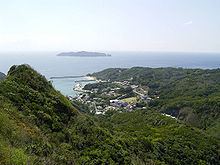Highest elevation 462 m (1,516 ft) Population 450 (2009) Elevation 462 m Max length 3.7 km | Highest point Chibusayama Pop. density 22.6 /km (58.5 /sq mi) Area 19.88 km² | |
 | ||
Hahajima (母島, meaning "Mother Island") is the second-largest island of the Ogasawara Islands or Bonin Islands south of the Japanese main island chain. It is about 21 km2 (8 sq mi) in area with a population of 440.
Contents
- Map of Haha jima Hahajima Ogasawara Tokyo 100 2211 Japan
- Minamizaki beach hahajima island japan
- History
- Ecology
- Snails
- Birds
- References
Map of Haha-jima, Hahajima, Ogasawara, Tokyo 100-2211, Japan
The highest points are Chibusayama, (literally "Breast Mountain"), approximately 462 metres (1,516 ft), and Sakaigatake, 443 metres (1,453 ft). The largest island of the group, Chichijima is located approximately 50 km (31 mi) to the north. Together with nearby smaller islands like Anejima and Imōtojima and Mukōjima, Hahajima forms the Hahajima Rettō (母島列島), or in former times, the "Baily Group".
The island is within the political boundaries of Ogasawara Village, Ogasawara Subprefecture, Tokyo, Japan.
Minamizaki beach hahajima island japan
History
The first European discovery of the Bonin Islands is said to have taken place in 1543, by the Spanish explorer, Bernardo de la Torre. Hahajima was originally called Coffin Island or Hillsborough Island and settled by Europeans before becoming part of Japan. In World War II, the Japanese government removed the locals and fortified the island; it was the target of several attacks by US forces during World War II. What is left of the defense works is now one of the tourist attractions of the island. The island can be reached by ferry in about two hours from Chichijima. The economy of Hahajima is based on commercial fishing, as well as a state-run rum distillery.
Today Hahajima has a population of 450, but the population was 1546 in 1904 and 1905 in 1940. There is one road from the (now-abandoned) village of Kitamura (北村) at the north end of the island to the village of Okimura (沖村) - formerly "Newport" at the southern end of the island, where the harbor is located. Ogasawara Village operates the island's public elementary and junior high schools. Tokyo Metropolitan Government Board of Education operates Ogasawara High School[1] on nearby Chichijima.
Ecology
Hahajima is of considerable interest to malacologists because of its endemic land snail fauna, including the eponymous Lamprocystis hahajimana. Due to the widespread presence of invasive species including goats (which destroy habitat) and rodents, flatworms and the rosy wolfsnail (which eat the native snails), it was feared that many of the endemics had become extinct.
But most if not all of the endemic land snail species seem to persist on the remote Higashizaki peninsula on the eastern coast. This is a quite pristine expanse of ground, scenic but very hard to reach (one has to climb Mt. Chibusa before descending to the peninsula). It consists of sheer seacliffs surrounding a plateau with Chinese fan palm (Livistona chinensis), pandanus and broadleaf (e.g. Persea kobu, a wild avocado) forest, and appears to be untouched by invasive species at present. It has been proposed that access to the area should be monitored, so that visitors will not inadvertently contribute to destroying this unique area.
Snails
All of these snails are endemic at least to the Ogasawara Islands.
Birds
Among birds, the Bonin white-eye (Apalopteron familiare), a gaudy-colored passerine, seems to occur nowhere else anymore than on Hahajima. The extinct Bonin grosbeak (Chaunoproctus ferreorostris) is sometimes said to have occurred in the Hahajima Group (though not on Haha-jima itself), but this seems not to be true. Columba janthina nitens, the Ogasawara subspecies of the Japanese wood-pigeon, used to occur on Haha-jima. While it is not precisely known when it vanished from this island, the taxon apparently became completely extinct during the 1980s.
